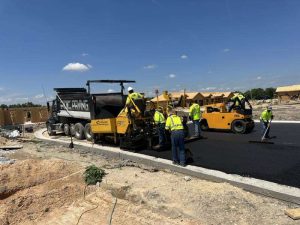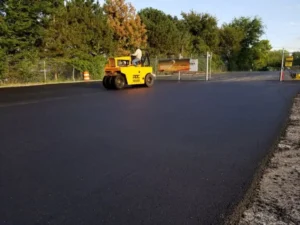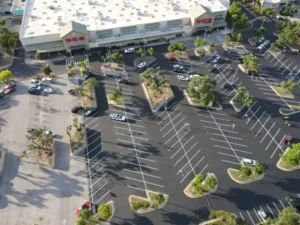Rutting
Rutting occurs when depressions begin to develop in areas of the asphalt where the wheels of vehicles tend to exert their weight (aka the wheelpath).
You can often see rutting develop on highly trafficked roads or even on driveways from the wear and tear of studded snow tires.
Rutting is basically a shifting of the subgrade or asphalt pavement layers due to consistent traffic, and it is often caused by a lack of pavement thickness. When rutting happens, it can also produce “shearing” which is the uplifting of pavement along the borders of the rut.
It’s very easy to identify ruts after a rainstorm has passed through the area, as they will often be filled with water. On roadways in particular, puddle-filled ruts can be very dangerous as they can cause hydroplaning due to standing water.
Other common causes for rutting are weak asphalt mixes, lack of compaction of the subgrade, subbase or asphalt itself, or even the presence of moisture in the layers beneath the surface.
If the rutting is stabilized or if it is somewhat minor, your paving contractor can simply fill in the rut and overlay it with fresh asphalt. For more severe rutting scenarios, the entire rutted area will need to be removed and replaced with brand new material.
Upheaval
Also known as “frost heave”, upheaval is a problem that typically results from subgrade soils expanding due to moisture that comes from frost or ice.
This expansion creates stress on the asphalt layers, resulting in the pavement being pushed upward and sometimes cracking when cars are driven over it.
Upheaval is quite common in colder climates, as ice “lenses” (layers) forming within the subgrade soil beneath the pavement, begin to expand as long as there’s an available supply of moisture on hand.
These ice layers can siphon water from all directions, even as far away as 20 feet from the main location of the ice lens.
Clay or silt soils are typically more susceptible to upheaval due to inferior drainage qualities, while soils that feature a good combination of sand and gravel can stem the flow of water via capillary action.
To fix this type of issue, your paving contractor will normally have to perform a full-depth patch, replacing not only the irregular asphalt layer but also the layers and subgrade beneath it.
Shoving
Also known as “washboarding”, shoving happens when ripples begin to form across the surface of the pavement.
It is not uncommon for shoving to develop in sections of asphalt that also have horizontal stresses, such as where one road meets another.
One of the most common reasons for shoving is excess asphalt being used in the installation by inferior paving contractors.
Other common causes of shoving include using asphalt that is too soft, a weak or insufficient granular base, and/or an asphalt mix that contains excessive quantities of fine aggregate. Shoving can also be caused by excessive moisture content in the subgrade.
Your paving contractor will address shoving problems by performing a partial or full-depth patch, depending upon the severity of the problem.
Depressions
Also known as “bird baths”, depressions are exactly what they sound like – dips or depressions within a certain section of the pavement that are lower than the elevation of the surrounding pavement.
Like ruts, depressions can fill with water (hence the bird bath reference) and if left in disrepair, they can continue to worsen until they turn into an even bigger surface problem.
Depressions are often caused by settlement in the lower layers of the payment, or some other structural failure that has occurred beneath the surface of the blacktop.
We hate to sound like a broken record here, but depressions are yet another problem that can be traced back to poor installation practices.
Without implementing proper asphalt paving techniques, an unskilled or inexperienced paving contractor can set the stage for depressions and other distortions to develop.
To fix depressions, your paving contractor will first of all assess the severity of the problem. If the depression isn’t that bad, it is possible that only an infrared patch or thin surface patch will be needed.
For severe depressions, more than likely your paving contractor will need to remove and replace the problem area entirely.
Raveling
Raveling is a common problem in very porous asphalt, and it happens when the aggregate particles in the pavement begin to loosen, separate, and wear away.
In a sense, you could actually rename raveling “unraveling” because that’s essentially what the pavement material is doing – it’s continuing to erode away leaving pock marks, chips, chunks, and an overall jagged appearance in its wake.
There are several reasons why raveling occurs, but one of the most common culprits is – you guessed it – poor installation practices. If an inferior asphalt mix was used, or if the binder was of a poor quality, it can negatively affect the durability of the blacktop surface.
Patch Failures
Sometimes there are cases where the asphalt repairs themselves will need to be repaired.
This holds true in terms of patch failures, which is an area of asphalt that has been patched but may have experienced excessive distress or deterioration.
This can be due to a number of factors including poor compaction, the quality of the asphalt mix, and/or the quality of the underlying or surrounding pavement.
Unfortunately, in the world of asphalt repair, there are many unscrupulous contractors who would rather cut corners than do a high-quality job in order to boost their bottom line. As you can see, this doesn’t just apply to the initial installation, but to repair work as well.
Fortunately, an experienced paving contractor can remedy the situation by keeping patch failures from rearing their ugly heads again.
Depending upon the severity of the problem, your paving contractor will perform either a partial or full-depth patch to restore the defective area and bring it back up to the required standard.
Potholes
Almost everyone is familiar with what these are, especially if you’ve accidentally hit one while you were driving.
Potholes represent nearly full-scale structural failure in an area of the asphalt, often displaying a deep, bowl-like depression that reaches down to the subbase.
Potholes typically have sharp or abrupt edges, and they can wreak havoc on tires and/or front end alignments.
They are often the end result of alligator cracking that has been left unattended. When vehicles roll over this type of area enough times, the persistent pressure can begin to knock chunks of pavement out of the affected area, making the conditions ripe for a pothole to develop.
Common factors that contribute to the formation of potholes include substandard asphalt mixture, weak areas in the subgrade or subbase, and/or using low-quality binding agents.
For this type of extreme surface damage, your paving contractor will need to perform a full-depth replacement patch to repair the damaged asphalt.
Other Asphalt Repair and Maintenance Issues
One of the best ways to curtail expensive asphalt repairs is to have your paving contractor perform regular routine maintenance on your blacktop installation which can include sweeping, sealcoating, and crack filling.
Sealcoating in particular is one of the most vital maintenance items to keep at the top of your list, as it will help protect the surface layer of the blacktop from moisture penetration as well as harmful UV rays from the sun.
If asphalt is not properly sealed on a periodic basis, it will begin to dry out due to excessive UV exposure, which can cause the pavement to lose its flexibility.
When this happens, cracking and accelerated deterioration are basically inevitable. Your best bet is to have your paving contractor apply sealcoating to your pavement every 2-4 years for optimal results.
The exact amount of time will ultimately depend on the overall wear and tear of your asphalt surface and the severity of your climate conditions.
Below are some of the most common obstructions that need to be removed in order to apply proper sealcoating:
1. Grass:
If you’ve ever seen a parking lot, driveway, or even a tennis court that has been neglected for a long time, you will often observe grass growing through the many cracks that have formed in the asphalt.
Of course, pavement jobs that are in such an extreme state of disrepair are typically the result of months or years of performing little to no maintenance.
The ideal scenario is for your paving contractor to clean out the cracks using a heat lance before sealing them, so that grass or other organic debris will not get a chance to grow.
A heat lance is basically a tool that burns out any vegetation while also evaporating moisture and blowing debris and dirt out of the cracks in the blacktop.
2. Oil Spots:
Leaky vehicles are the nemesis of asphalt. Spots from oil and other automobile-related chemicals are an extremely common problem for driveways and parking lots.
If left unattended, they will eventually eat away at the surface layer of the blacktop, causing damage and eventual deterioration.
Your paving contractor should thoroughly clean these areas before applying the sealant, which will help protect the blacktop from this type of damage in the future.
3. Tree sap, mud, berry stains, dirt, etc:
These types of natural substances can form a barrier between the sealant and the asphalt if the area is not thoroughly cleaned before application.

Your paving contractor will have all kinds of cleaning tools in their arsenal – from blowers and gas powered brooms to pressure washers and push brooms – to ensure that the asphalt has been sufficiently cleaned before applying any sealcoating.
Asphalt is one of the most durable paving materials on the planet but as you can see, it is far from invincible. The heavy and consistent use over time will eventually take its toll, which means that your pavement will eventually require some type of repair work.
Asphalt Repair: Bottom Line
The best route to go down is consulting with a qualified paving contractor who can assess whatever repair or maintenance needs might be necessary, and then carry them out with top-quality workmanship.
That’s what RDC Paving is all about: We’ll connect you with an experienced, reputable paving contractor who will take care of all your asphalt repair needs ASAP.
Contact us today to get your pavement installation on the fast road to recovery!











